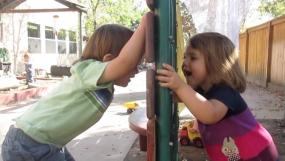A Universal Game for Toddlers

At this episode begins, Scarlett (22 months) uses eye contact to engage Jack (18 months). As they make eye contact. Scarlett runs away, only to turn back and engage Jack. This creates a back and forth game of catch and release. After a moment of eye contact, smiles, and laughter the game starts again. These spontaneous games likely come from a source that is universal and bespeaks of young children's ability to coordinate rules between themselves, without much structuring by adults.
In this example, Scarlett uses her understanding of the game, Peek-a-Boo, to engage her peer in an experience of shared joy. Scarlett enacts the format of the game by repeatedly “disappearing” and “reappearing”.
At first, Scarlett “reappears” from behind the sheer yellow fabric (0:00:04), but then peers at Jack through the open slots in the play structure (0:00:10). Which strategy do you think offers a greater element of surprise and why?
What effect do you think Scarlett may be trying to create when she pauses and turns back to gaze at Jack for several seconds (0:00:37 to 0:0042)?
Why do you think Jack decides to wait at the play structure and return her gaze rather than pursue Scarlett (0:00:39 to 0:00:42)? What do you think he understands about the rules of the game and his role?
As the game continues, Scarlett varies how she “reappears” in subtle ways (0:00:51, 0:00:58, 0:01:03, 0:01:08, etc). Describe what she does. When does she elicit the strongest response from her peer?
The children do not exchange words per se. What strategies do you notice Jack and Scarlett using to create shared meanings?
In what ways do you think the children’s interaction might resemble a conversation? Explain how games with a predictable structure (e.g., Peek-a-Boo), may support language development.
At time code 0:01:25 Scarlett turns to the camera and says something like, “I saw”. Why is this moment noteworthy?
Overall, what can children learn from early social games that may later support shared understandings with others?
